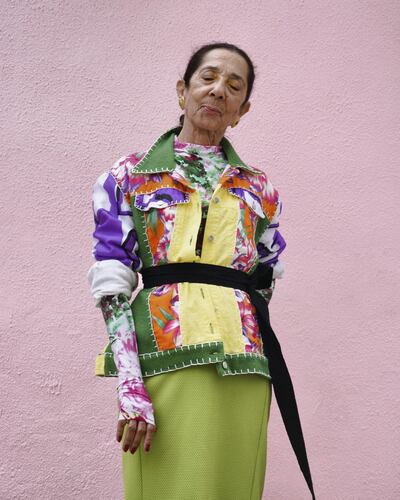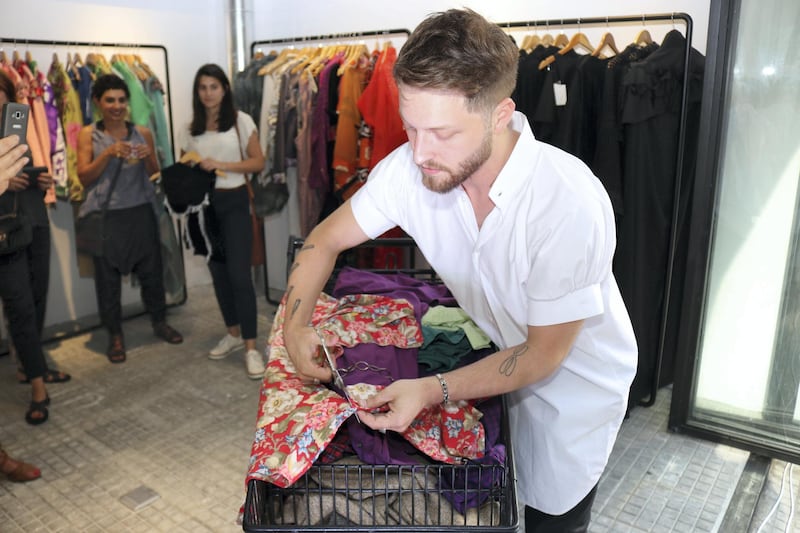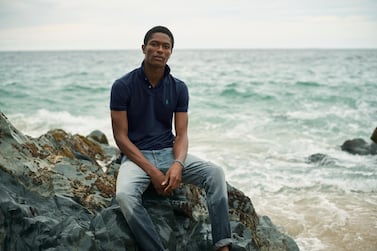During the launch party for Emergency Room, a clothing boutique in Beirut, visitors were surprised to find a metal shopping trolley in the middle of the store, filled with second-hand garments. Hanging from the sides were two pairs of tailoring scissors. Guests were invited to choose a garment and cut it up. By the end of the night, the trolley was overflowing with old clothes bearing new holes and fraying edges – not ruined, but ready for reinvention.
Founded just over a year ago, Emergency Room aims to provide a sustainable and ethical alternative to fast fashion through one-off upcycled apparel handmade in Lebanon. The brand’s first permanent boutique opened this summer in Mar Mikhael, and features garments dreamt up by Lebanese-French designer Eric Mathieu Ritter, and stitched by tailors in Tripoli and Beirut. Using unexpected materials – from old bed sheets, curtains and fabric designed to upholster sofas, to a roll of waterproof tablecloth printed with a misaligned advert for a German beer – Ritter designs statement pieces that promise to make the wearer stand out.
“It’s a brand based on two axis: the ethical treatment of garment workers and the sustainable side of fashion, which is the promise to use only deadstock fabric and second-hand clothes,” explains Ritter.
Finding early inspiration
Inside the small boutique, colourful outfits hang on three simple racks. A men’s suit jacket has been taken apart and cleverly refashioned as a flowing ruffled cape. A delicate length of semi-sheer purple silk finds new life as a dress with an elegant split up its back. A textured red jacket has been cut up and given new sleeves in a contrasting cream weave, encircled with thick cotton bands that can be cinched and buttoned at the wrists. Browsing the collection is akin to a treasure hunt – most items are one-of-a-kind pieces, sold once to never be recreated.
Ritter, who decided he wanted to be a fashion designer at the age of 14, studied pattern-making and design at Esmod Beirut. After graduating, he spent a year working in the atelier of luxury Lebanese designer Zuhair Murad. Next, he created a collection for a charity project in Tripoli, which empowers local women by training them in sewing, embroidery, knitting and crochet. Ritter was on the verge of leaving Lebanon soon after, but ended up working with the women for two years, as part of a co-operative called Tara W Kheit. Emergency Room grew naturally from this collaboration.
A focus on sustainability
The name of the brand, which is based on the designer’s initials, reflects Ritter’s belief that fashion – one of the world’s most polluting industries – is in vital need of help. “You go to the emergency room when something is very wrong,” he says. “I wanted this brand to stand for the urgent need to do things differently, to face fast fashion, and the way it’s polluting the Earth and also mistreating garment workers. I decided to call it Emergency Room because fashion is sick.”
Inviting customers to cut up garments during the launch party for the boutique was one way to get them thinking about recycling and sustainability. “At first they were a bit hesitant, but by the end they were all joyfully cutting away,” he says. “The promise was that I would use whatever they cut to create another set of clothes. So it engaged people in conversation and allowed the customer to be included in the design process.”
Taking a sustainable approach to materials, Ritter scours thrift shops in Tripoli’s ancient souks for garments that he can redesign and embellish to give them a new lease of life. Other pieces are made from scratch using high-quality fabrics from rolls that are partially damaged or almost finished, known as deadstock. Saving money on materials allows Ritter to pay the dozen or so tailors he works with more per piece, as well as ensuring that unwanted fabric doesn’t end up in landfill.
“Each piece is unique because often we cannot find large quantities of the same fabric, so that shaped the eclectic DNA of the brand,” he says. “It has also changed my perception of design, which used to be that you imagine something, do a sketch and then create it, whereas here it’s more like cooking [with leftovers], where you have to see what you can find.”
A new approach on social media
Emergency Room's Instagram page sets an unusual example, too. As well as showcasing the clothes, it also features photographs of the tailors who work on them. "It's important for me to credit each person who is building the brand because, at the end of the day, it's a collaborative effort," explains Ritter. "Fast fashion has conditioned people to think that clothes are disposable … It's important to show the garment workers, so buyers realise that by buying from local designers or by buying slow fashion, real people are benefiting."
Ritter hopes that reminding customers of the time and effort that goes into each piece will encourage them to reflect on why ethical fashion necessitates higher prices than most high-street brands, which mass-produce millions of garments in vast factories, exploiting cheap labour overseas. The prices at Emergency Room start from $60 (Dh220) for a simple top, averaging $120 for a tailored shirt and culminating at $320 for a one-off upcycled jacket.
The clothes are intended to appeal to a diverse audience, an approach reflected in the campaign that marked the launch of the boutique at the end of June. Rather than creating a slick photo shoot with professional models, Ritter worked with a large cast of local Beirutis, capturing them on the streets of the city.
"I [didn't] want to leave anybody out. The clothes are eclectic, and I wanted to have a similar cast of models instead of stereotyping [a single] beauty standard. This is also something that comes from fast fashion – it shows you people who are always happy and handsome … I wanted to provoke a different reaction. I wanted people to feel represented and like they could connect with the brand."
The 25 "models" who agreed to pose for the campaign are of different genders, ethnicities, ages and backgrounds with a wide range of body types. Ritter even convinced his grandmother, who is in her 80s, to take part. Hoda is captured in a vibrant patchwork jacket with panels of lemon yellow, lime green, bright orange and deep purple. The photographs were fly-posted around the Lebanese capital, mimicking the way politicians emblazon their faces on the city's walls during election campaigns.

Ritter rejects the idea of specific lines for men and women, instead encouraging customers to browse every garment for something they like. His campaign includes images of a muscular man wearing a white lacy vest under a sheer turquoise silk shirt, and a slim, bearded man in a pale pink jacket embellished with fuchsia and turquoise tassels. “I call it gender-fluid. Everything I do, I like to think that it’s unisex.
“I wear a lot of the designs myself, but there have been comments that a lot of guys don’t find pieces here. So I decided to do a capsule collection that is more masculine in the traditional sense of the term,” says Ritter, who has just finishing shooting a new menswear collection of 60 garments – using a cast of 12 models that include a transgender man and two women. “It’s important to me that even if I’m going to label something as masculine, I’m also going to do something on the other side to break that down … to provoke conversation.”






